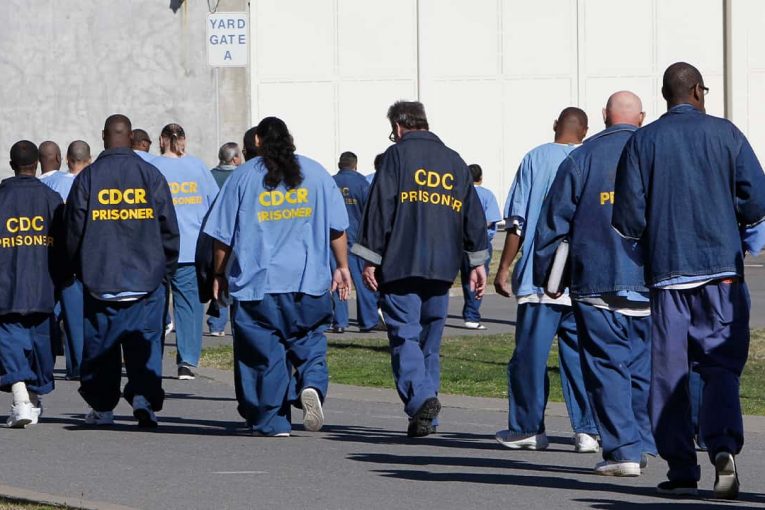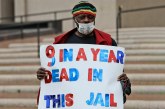
By Julietta Bisharyan and Nick Gardner
Incarcerated Narratives
At San Quentin State Prison (SQ), the novel coronavirus has now claimed the lives of 28 incarcerated individuals, including one correctional officer.
Marcus Henderson described his experiences witnessing the prison outbreak in an editorial published in the San Quentin News.
Henderson recalls the sound of the incarcerated emergency medical alarms ringing throughout the housing units as correctional officers march through the prison.
He describes the image of medical nurses administering aid, dressed in Personal Protection Equipment (PPE), as “resembling a sci-fi movie.”
He asserts that the incarcerated population has had to fight for many of their rights, such as religious rights, access to the courts, to end the indefinite use of solitary confinement and to win adequate healthcare.
“Even in these times of crisis, it feels that we (the incarcerated) always have to prove our humanity, our rehabilitation and our willingness to make amends,” Henderson writes.
Henderson mentions the debate surrounding early releases and whether or not they should be applied only to non-violent offenders versus those who have committed violent crimes.
According to CDCR’s own recidivism study, over 50% of prisoners, who paroled after completion of a determined sentence, were convicted of a new crime within three years. On the other hand, only 5% of lifer parolees were convicted of a new crime within three years.
In addition, a study done by Stanford University between 1995 and 2010 found that only 5 out of 860 murderers paroled in California returned to prison for new felonies but none that required a life term.
“So it pains most of us who have done the internal work—those who have worked through the childhood traumas and accepted accountability—to still be considered politically “risky” and not for safety reasons,” writes Henderson.
“As the coronavirus spreads and becomes our new reality, our fears of death are real. All we hope for is for society to remember whatever the deed was, most of us weren’t sentenced to death by the state.”
CDCR Confirmed COVID-19 Cases and Outcomes
As of Nov. 6, there have been 16,233 total confirmed COVID-19 cases in the CDCR system – 837 of them emerged in the last two weeks. 5.3% of the cases are active in custody while 2.8% have been released while active. Roughly 91% of confirmed cases have been resolved.
There have been 81 deaths within the CDCR facilities. 20 incarcerated persons are currently receiving medical care at outside health care facilities across the state.
On Oct. 30, an incarcerated person from Avenal State Prison (ASP) died at an outside hospital from what appears to be complications related to COVID-19. This is the eighth incarcerated person death from COVID-19 at ASP, according to CDCR.
California Institution for Men (CIM) also reported its 27th death this week, bringing its total to one shy of San Quentin’s death toll.
Another death was reported at Pleasant Valley State Prison (PVSP) on Nov. 5. This is the first death at PVSP.
Pelican Bay State Prison (PBSP) reported two more active cases this week since recently confirming its first one.
Currently, Substance Abuse Treatment Facility (SATF) leads with the highest amount of active cases –– 456. Chuckawalla Valley State Prison (CVSP) follows behind with 191 active cases.
In the past two weeks, Valley State Prison (VSP) has tested the most, 79% of its population. California Institution for Women (CIW) has tested the least, just 12% of its population.
On Oct. 30, CDCR updated its CDCR/CCHCS Employee Testing Guidance and CDCR/CCHCS entrance screening criteria.
“The purpose of a surveillance testing strategy is to detect new cases, prevent spread, and mitigate outbreaks. This is especially relevant in COVID-19 due to the high proportion of asymptomatic cases,” reads the new guidelines.
The memo noted that the new policy is subject to change as the Centers for Disease Control and Prevention and California Department of Public Health guidelines are updated as well as PPE availability and testing resources and availability change statewide.
CDCR also issued updated guidance to staff regarding facial coverings and physical distancing in the Staff Wearing Facial Coverings and Physical Distancing Requirements Memo. The memo includes a checklist for Regional Health Care Executives and Associate Directors, or designees, to conduct compliance visits at their respective sites.
According to the memo, staff and incarcerated individuals are required to wear masks and practice social distancing in all areas of the prison, or they will be written up for non-compliance.
Any supervisors or managers who fail to enforce these directives will be subject to progressive discipline.
There are currently 97,614 incarcerated persons in California’s prisons – a reduction of 24,795 since March 2020, when the prison outbreaks first began.
Effect on the Public
James King, a 51 year old resident at San Quentin State Prison, spoke with KTVU 2 News to discuss the consequences of the CDCR’s transferring of incarcerated individuals between institutions.
For starters, a transfer from San Quentin is “by no stretch a solution”— Avenal State
Prison and California State Prison, Solano are noticeably over-crowded , housing 126 and 119 percent of their maximum capacity, respectively. Transferring to another institution would likely put King and others in a similar predicament, with CDCR institutions currently sitting at a combined 105 percent capacity.
Medical reasons aside, transfers would be remove individuals from an environment that provides them with programs such as college classes, computer coding, and newspaper positions in exchange for what King describes as “a prison in the desert [that] would detract from the quality of lives.” Additionally, many of those housed in San Quentin would no longer enjoy the close proximity of family members, many of whom live in the Bay Area.
“People have lives,” King told KTVU 2 on Friday. “Picking up and moving affects people.”
The very idea of new transfers arriving and departing from the Marin County facility is unsettling for many of those within San Quentin, especially those who had to live with the fatal consequences of the CDCR’s decision to transfer incarcerated individuals from the California Institution for Men in May. Since then, roughly 75 percent of San Quentin’s residents have contracted the deadly virus that has claimed the lives of 28 prisoners and one guard.
Discussion of mass transfers is a salient topic following a San Francisco appellate court’s order to reduce San Quentin’s population by roughly half of its stated capacity, a decision that stemmed from resident Ivan Von Staich’s lawsuit contesting the effectiveness of social distancing conditions within the prison. The decision will give CDCR the option to either transfer or release individuals in order to meet the court-mandated quota. In a recent statement to the San Francisco Chronicle, a CDCR spokesperson assured that no individual will be transferred to any facility housing active cases.
One current strategy being implemented by the CDCR is the transferring of individuals into solid-door cells, which have been proven to protect incarcerated individuals from the airborne coronavirus. However, following the Von Staich decision, 238 of 302 San Quentin residents deemed highly vulnerable are refusing to move cells.
“There are times when the demands of public health can overcome patient preferences,” said J. Clark Kelso, who controls health care in the California state prisons. But in this case he said the transfers would mainly benefit individual inmates. “What we can and must do is fully educate our patients about the comparative COVID-19 risks of dorm housing versus celled housing.”
Kelso has recommended that 8,200 high risk individuals currently housed in open-cell units be offered the decision to transfer. This would involve rearranging more than 8 percent of the CDCR’s incarcerated population.
Proponents of decarceration, such as San Francisco Deputy Public Defender Danielle Harris, believe that these individuals should be released. Harris, who is leading a Marin County case on behalf of 324 San Quentin residents, argues that the transfers could be safely reintegrated back into the public, and in some cases may even enhance the safety of their communities. Many of them are above the age of 60, and years of rehabilitation coupled with the decline in criminal fervor with age deem them “low risk”— an evaluation backed by CDCR personnel.
Harris wants individuals out of crowded institutions and back into communities where they can safely distance themselves and reintegrate into society. But in order to accomplish this, decisive leadership is crucial.
“We don’t want anyone to be released without a solid plan,” Harris remarked. “We have set people up to succeed.”
—-
Attorneys are warning that San Quentin is at risk of a “second, or even a third surge” of coronavirus if the incarcerated population is not significantly reduced soon.
Lawyers on behalf of 300 San Quentin residents delivered this warning in a written address to Superior Court Judge Geoffrey Howard on Tuesday. The team, a collaboration of San Francisco, Marin County, and Alameda County public defenders, along with the private firm Keker, Van Nest & Peters, urged Judge Howard to hold an evidentiary hearing on the state of safety conditions at San Quentin.
The attorneys hope to convince the Court that releasing hundreds of incarcerated individuals from San Quentin is the most effective means of combating an airborne virus in arguably the most difficult setting to control it. Incarcerated individuals older than 60, eligible for parole, at high medical risk, or with more than 25 years of their sentence served will be prioritized for earl release as part of the plan.
Lisa Strawn, a 61 year old resident at San Quentin, is among those satisfying the requirements for early release should the attorney’s arguments prove convincing to Judge Howard.
“I didn’t think I would make it out after 25 years,” Strawn said in an interview with KTVU. “Now I’ve been through a lot. But nothing compares to getting COVID-19. I still have issues of taste and smell and the psychological after-effects are still there. Not enough was done then to protect us all. You simply can’t keep moving people around.”
The attorneys’ request follows a favorable ruling in In re Von Staich, which produced a mandate requiring San Quentin’s population be reduced by half after the Court determined that social distancing conditions within the institution were ineffective at current capacity.
The Von Stacih decisions gives the CDCR say in whether individuals are transferred or released. However, with the entire CDCR system operating at 105 percent capacity, and 13 institutions as high as 120 percent, the attorneys argues that transfers would further harm those at San Quentin and other facilities.
The court filing included the professional opinion of Dr. Joseph Bick, the director of healthcare services at San Quentin, who urged the CDCR to limit movement when possible.
CDCR Staff
There have been at least 4,575 cases of COVID-19 reported among prison staff. 10 staff members have died while 4,081 have returned to work. 494 are still active.
CDCR Comparisons – California and the US
According to the Marshall Project, California prisons rank fourth in the country for the highest number of confirmed cases, following Texas, Florida and Federal prisons. California makes up 9.4% of total cases among incarcerated people and 5.8% of the total deaths in prison.
California also makes up 11.5% of total cases and 11% of total deaths among prison staff.
Division of Juvenile Justice
As of Nov. 6, there are no active cases of COVID-19 among youth at DJJ facilities. 70 cases have been resolved.




